Bài giảng Xử lý tín hiệu số - Chương 4: Fir filtering and convolution - Hà Hoàng Kha
Content
Block processing methods
Convolution: direct form, convolution table
Convolution: LTI form, LTI table
Matrix form
Flip-and-slide form
Overlap-add block convolution method
Sample processing methods
FIR filtering in direct form
Ha H. Kha 2 FIR Filtering and ConvolutionIntroduction
Block processing methods: data are collected and processed in blocks.
FIR filtering of finite-duration signals by convolution
Fast convolution of long signals which are broken up in short segments
DFT/FFT spectrum computations
Speech analysis and synthesis
Image processing
Sample processing methods: the data are processed one at a timewith each input sample being subject to a DSP algorithm which
transforms it into an output sample.
Real-time applications
Digital d audio effects processing
Digital control systems
Adaptive signal processing
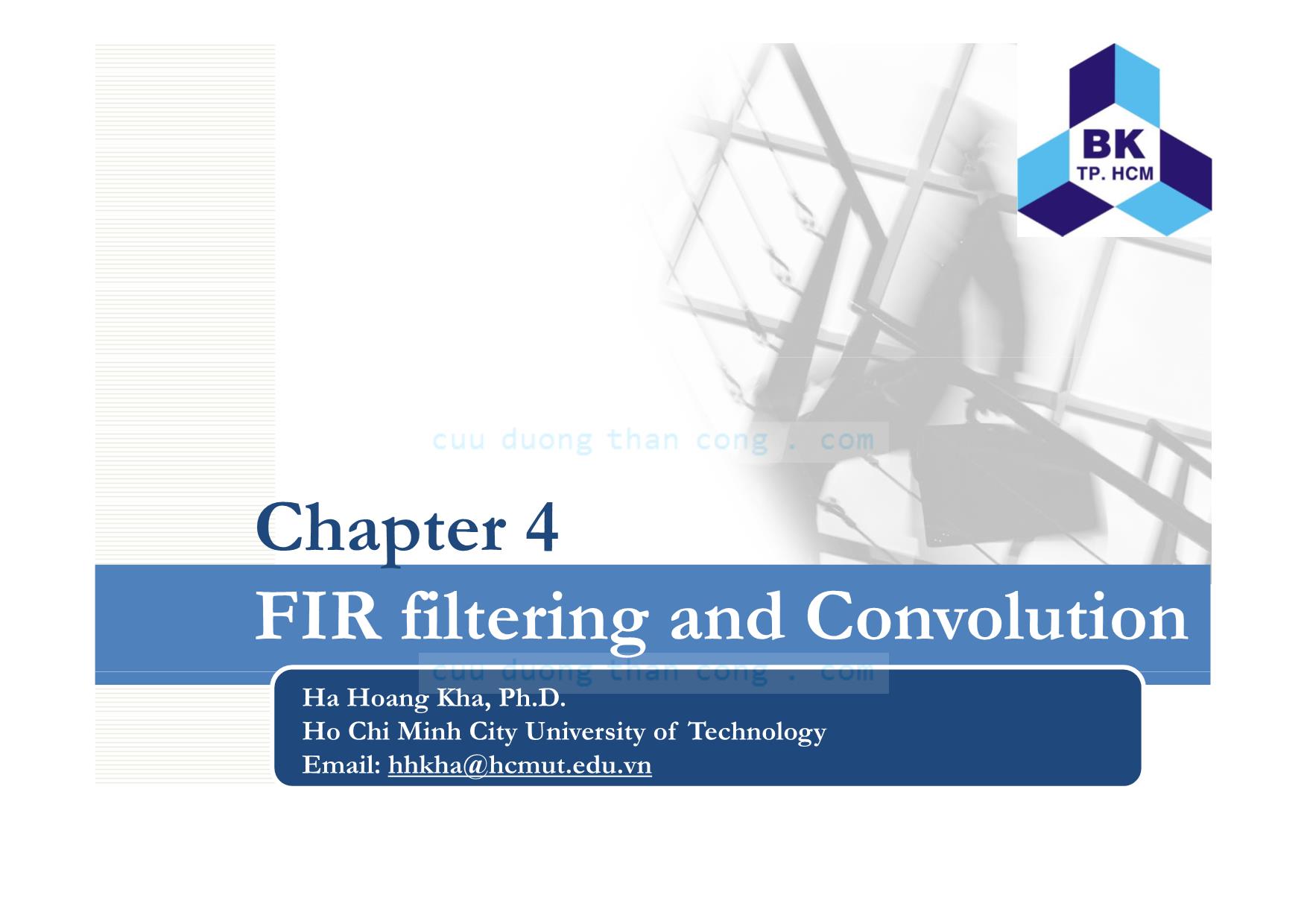
Trang 1
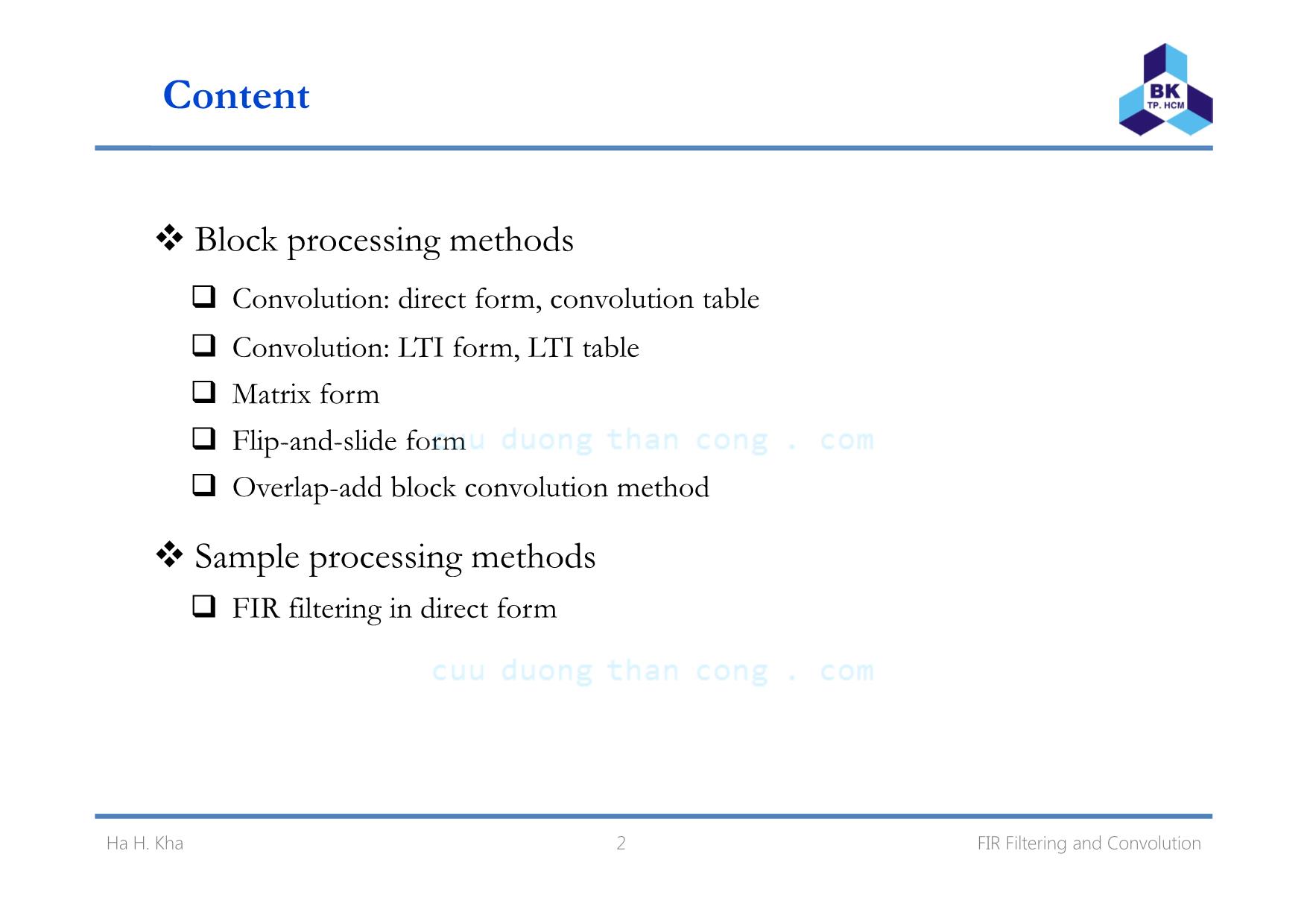
Trang 2

Trang 3
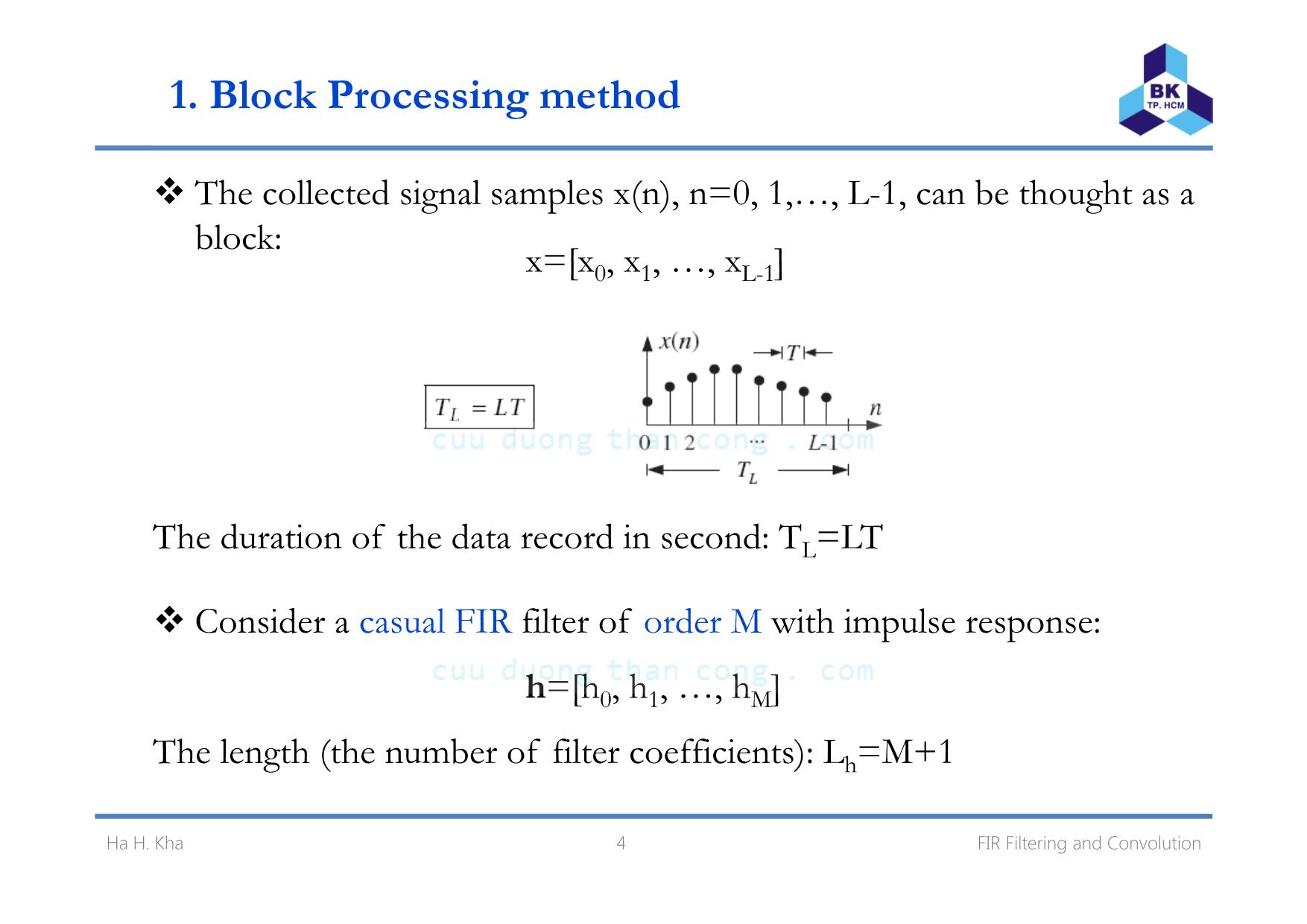
Trang 4
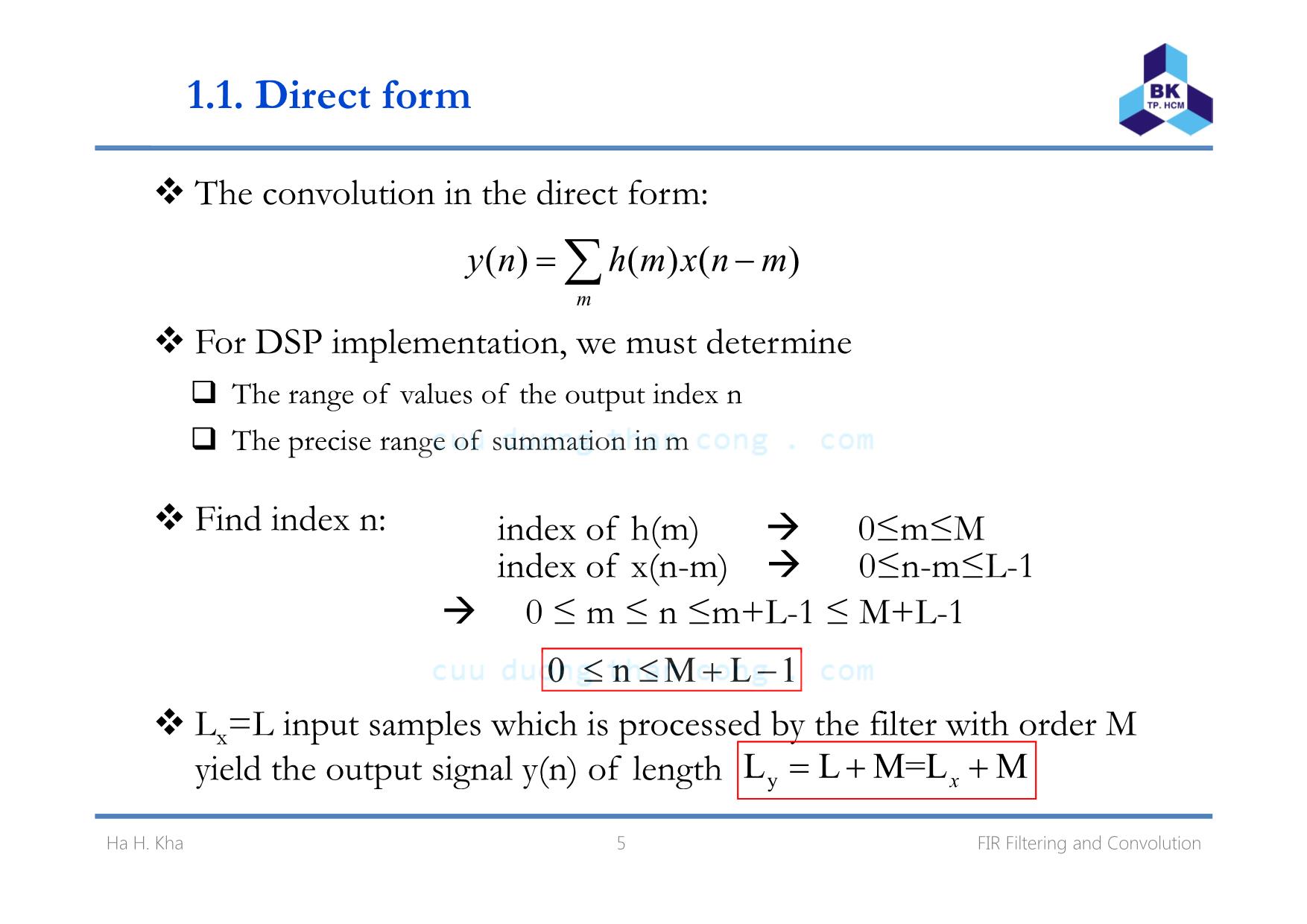
Trang 5
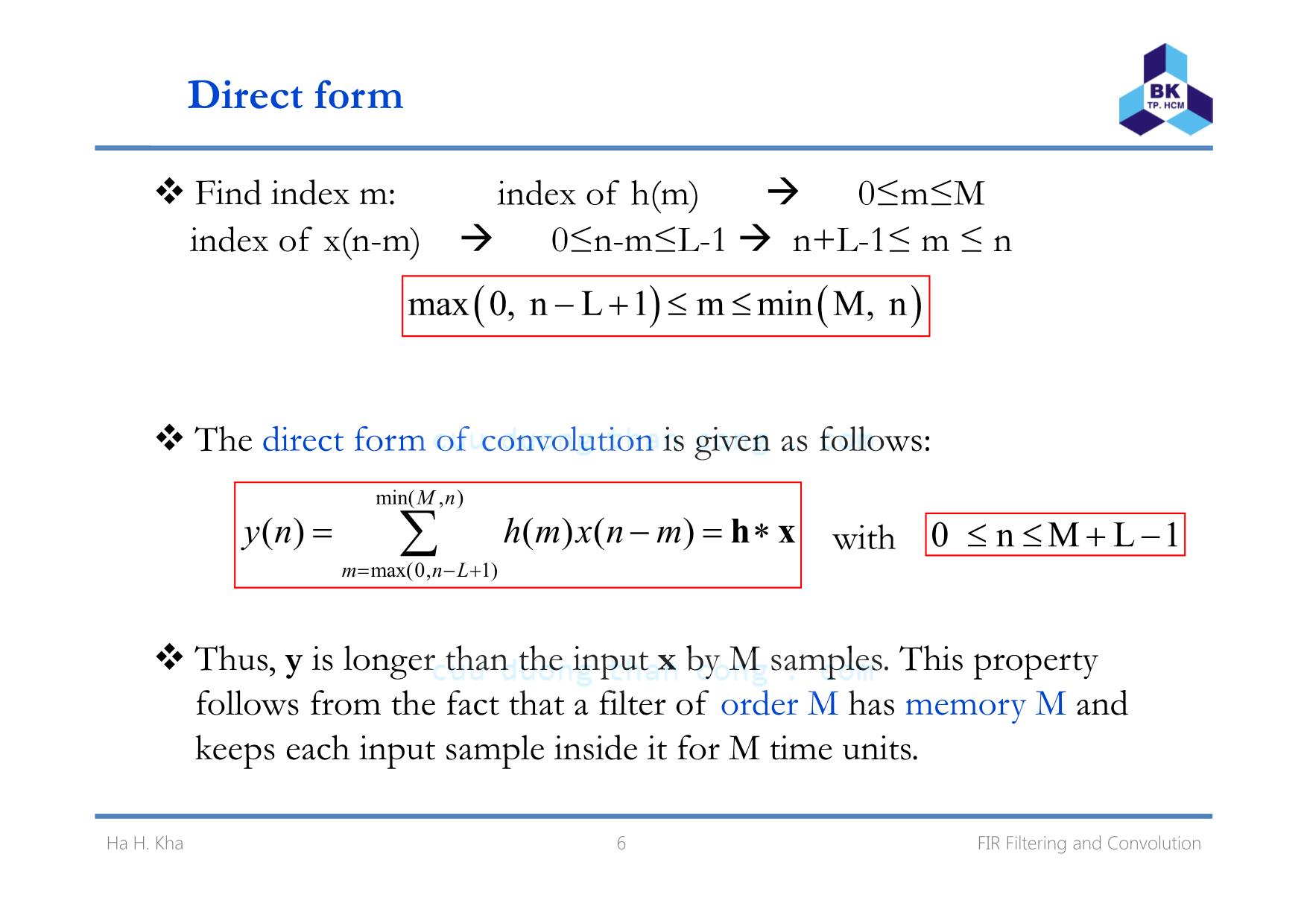
Trang 6
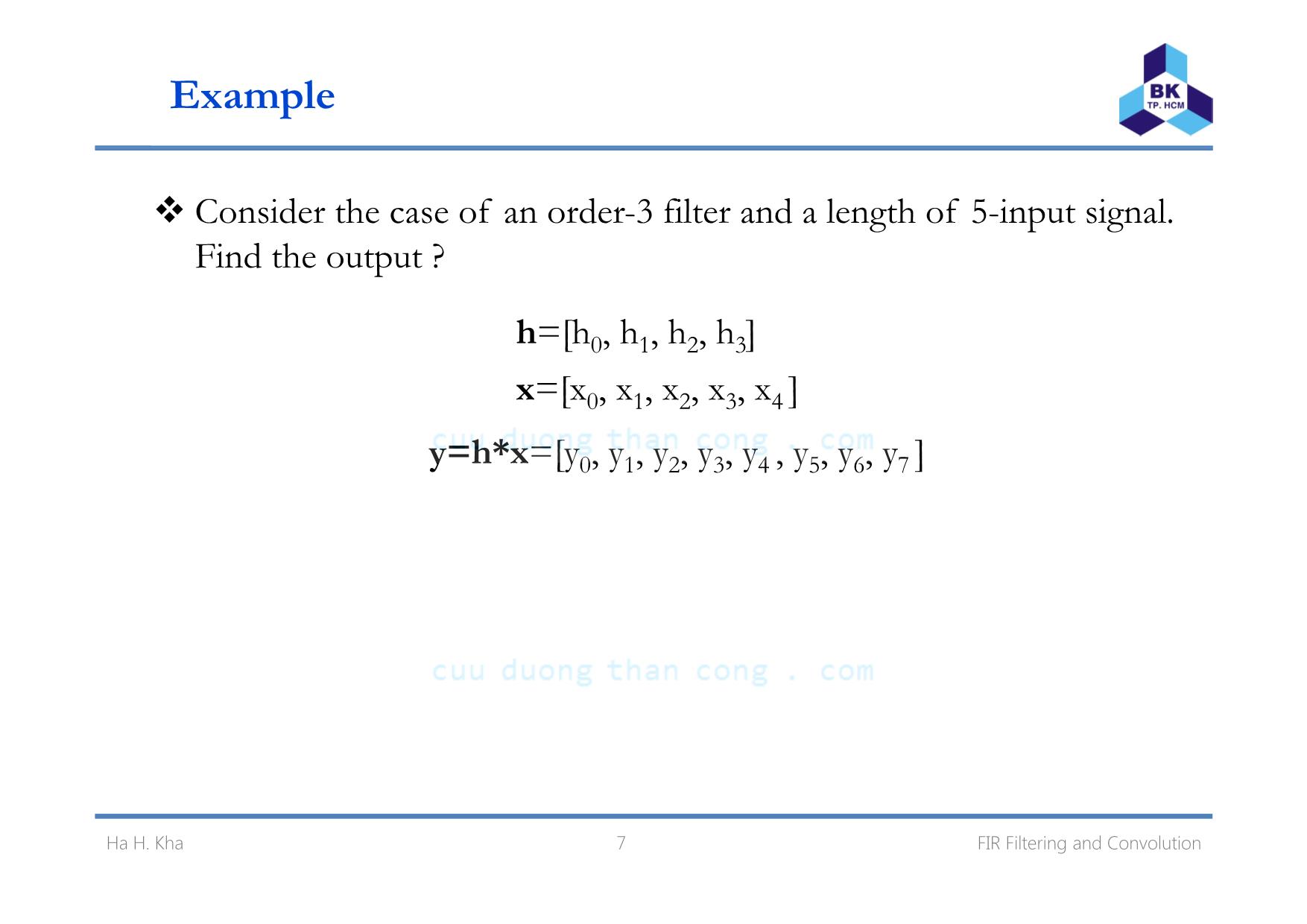
Trang 7
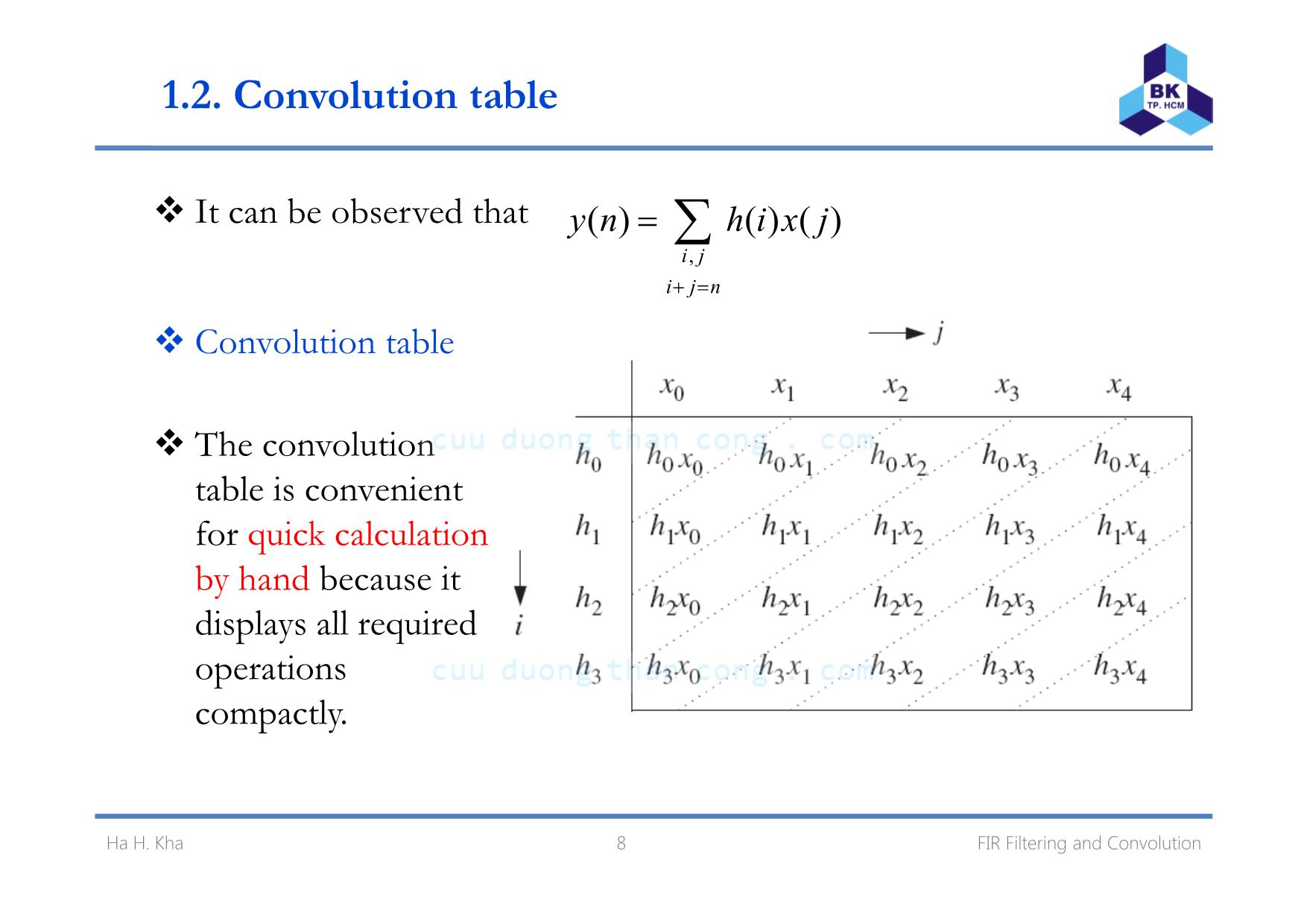
Trang 8
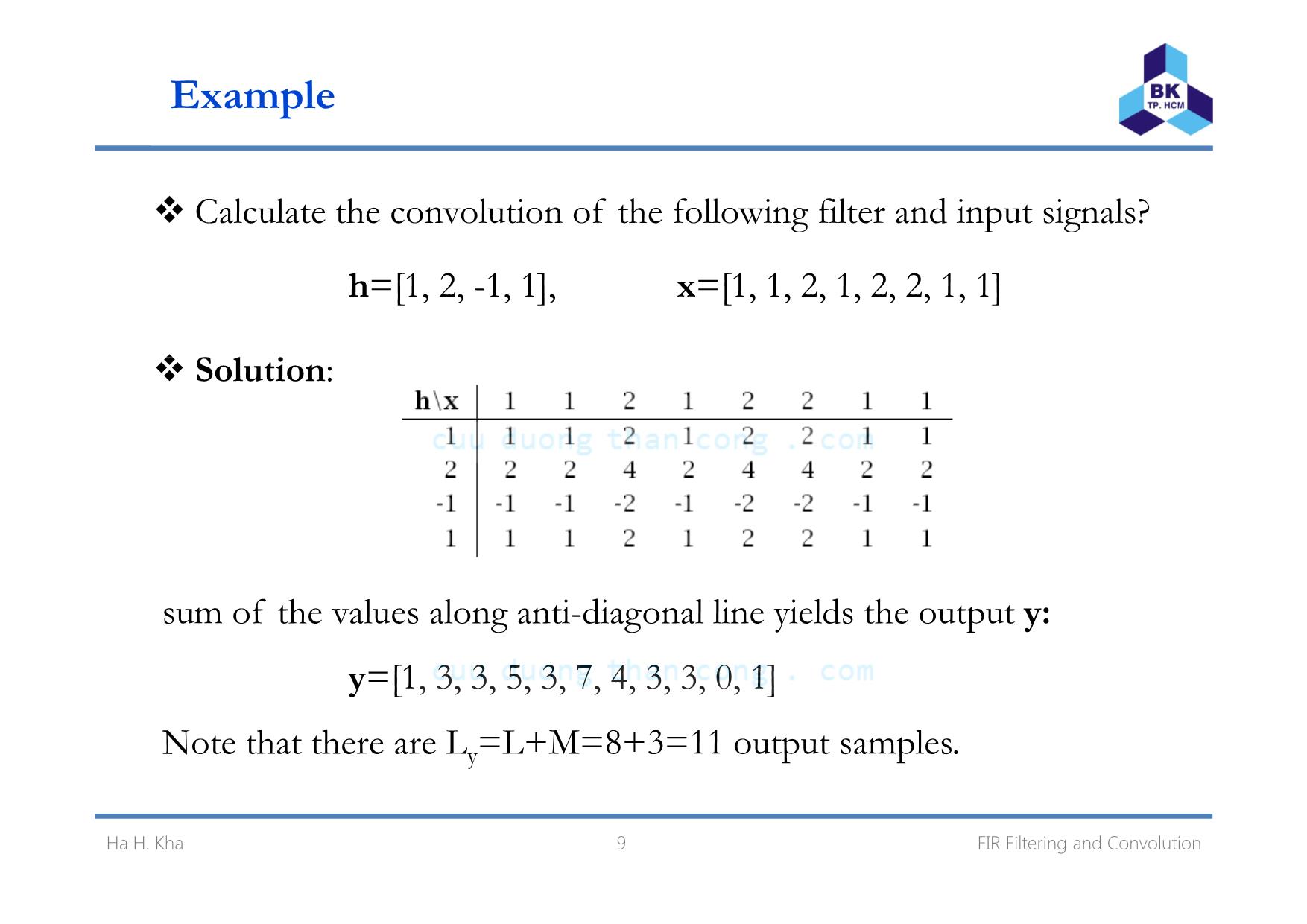
Trang 9
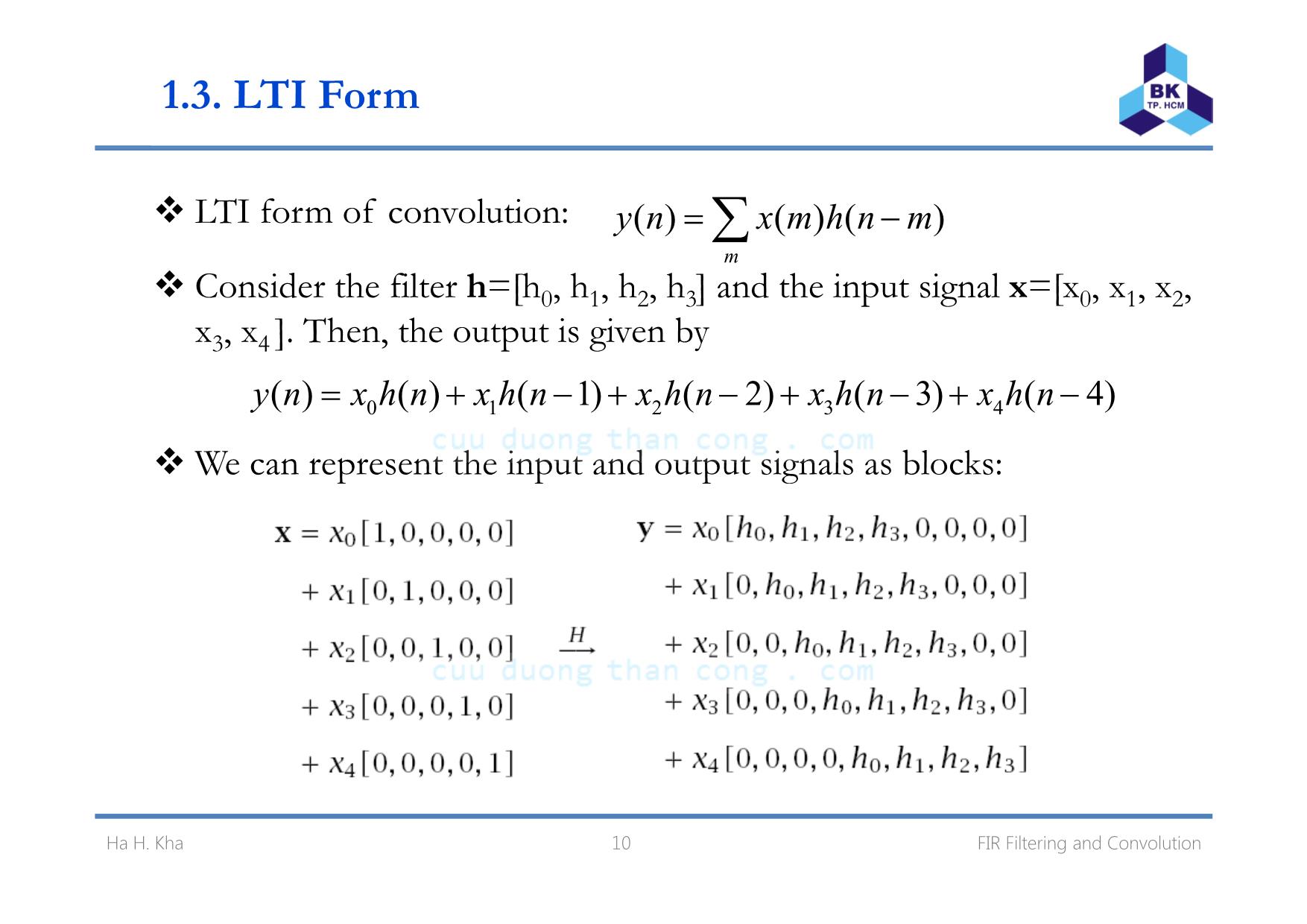
Trang 10
Tải về để xem bản đầy đủ
Tóm tắt nội dung tài liệu: Bài giảng Xử lý tín hiệu số - Chương 4: Fir filtering and convolution - Hà Hoàng Kha
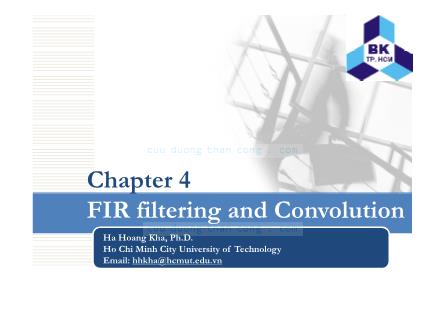
Chapter 4 FIR filtering and Convolution Click to edit Master subtitle styleHa Hoang Kha, Ph.D. Ho Chi Minh City University of Technology Email: hhkha@hcmut.edu.vn Content Block processing methods Convolution: direct form, convolution table Convolution: LTI form, LTI table Matrix form Flip-and-slide form Overlap-add block convolution method Sample processing methods FIR filtering in direct form Ha H. Kha 2 FIR Filtering and Convolution Introduction Block processing methods: data are collected and processed in blocks. FIR filtering of finite-duration signals by convolution Fast convolution of long signals which are broken up in short segments DFT/FFT spectrum computations Speech analysis and synthesis Image processing Sample processing methods: the data are processed one at a time- with each input sample being subject to a DSP algorithm which transforms it into an output sample. Real-time applications l d ffDigita au io e ects processing Digital control systems Adaptive signal processing 3 FIR Filtering and Convolution Ha H. Kha 1. Block Processing method The collected signal samples x(n), n=0, 1,, L-1, can be thought as a block: [ ]x= x0, x1, , xL-1 The duration of the data record in second: TL=LT Consider a casual FIR filter of order M with impulse response: h=[h0, h1, , hM] The length (the number of filter coefficients): Lh=M+1 4 FIR Filtering and ConvolutionHa H. Kha 11.1. Direct form The convolution in the direct form: ( ) ( ) ( )h∑ m y n m x n m= − For DSP implementation, we must determine The range of values of the output index n The precise range of summation in m Find index n: index of h(m) Æ 0≤m≤M index of x(n m) Æ 0≤n m≤L 1 - - - Æ 0 ≤ m ≤ n ≤m+L-1 ≤ M+L-1 0 n M L 1≤ ≤ + − Lx=L input samples which is processed by the filter with order M yield the output signal y(n) of length L L M=L M= + + 5 y x FIR Filtering and ConvolutionHa H. Kha 1Direct form Find index m: index of h(m) Æ 0≤m≤M index of x(n-m) Æ 0≤n-m≤L-1 Æ n+L-1≤ m ≤ n ( ) ( )max 0, n L 1 m min M, n− + ≤ ≤ The direct form of convolution is given as follows: min( , ) (0 1) ( ) ( ) ( ) M n L y n h m x n m + = − = ∗∑ h x 0 n M L 1≤ ≤ + −with max ,m n= − Thus, y is longer than the input x by M samples. This property follows from the fact that a filter of order M has memory M and keeps each input sample inside it for M time units. 6 FIR Filtering and ConvolutionHa H. Kha Example Consider the case of an order-3 filter and a length of 5-input signal. Find the o tp t ? u u h=[h0, h1, h2, h3] x=[x0, x1, x2, x3, x4 ] y=h*x=[y0, y1, y2, y3, y4 , y5, y6, y7 ] 7 FIR Filtering and ConvolutionHa H. Kha 1.2. Convolution table It can be observed that ( ) ( ) ( ) i j y n h i x j= ∑ , i j n+ = Convolution table The convolution table is convenient for quick calculation b h d b iy an ecause t displays all required operations compactly. 8 FIR Filtering and ConvolutionHa H. Kha Example Calculate the convolution of the following filter and input signals? h=[1, 2, -1, 1], x=[1, 1, 2, 1, 2, 2, 1, 1] S l io ut on: sum of the values along anti-diagonal line yields the output y: =[1 3 3 5 3 7 4 3 3 0 1]y , , , , , , , , , , Note that there are Ly=L+M=8+3=11 output samples. 9 FIR Filtering and ConvolutionHa H. Kha 1.3. LTI Form LTI form of convolution: ( ) ( ) ( )y n x m h n m= −∑ m Consider the filter h=[h0, h1, h2, h3] and the input signal x=[x0, x1, x2, x3, x4 ]. Then, the output is given by 0 1 2 3 4( ) ( ) ( 1) ( 2) ( 3) ( 4)y n x h n x h n x h n x h n x h n= + − + − + − + − We can represent the input and output signals as blocks: 10 FIR Filtering and ConvolutionHa H. Kha 1.3. LTI Form LTI form of convolution: LTI form of convolution provides a more intuitive way to under stand the linearity and time invariance properties of the filter 11 FIR Filtering and Convolution - . Ha H. Kha Example Using the LTI form to calculate the convolution of the following filter and inp t signals? u h=[1, 2, -1, 1], x=[1, 1, 2, 1, 2, 2, 1, 1] S l io ut on: 12 FIR Filtering and ConvolutionHa H. Kha 1.3. Matrix Form Based on the convolution equations =y Hx x is the column vector of the Lx input samples. we can write y is the column vector of the Ly =Lx+M put samples. H is a rectangular matrix with dimensions (L +M)xL x x . 13 FIR Filtering and ConvolutionHa H. Kha 1.3. Matrix Form It b b d th t H h th t l h di l can e o serve a as e same en ry a ong eac agona . Such a matrix is known as Toeplitz matrix. Matrix representations of convolution are very useful in some applications: Image processing Advanced DSP methods such as parametric spectrum estimation and adaptive filtering 14 FIR Filtering and ConvolutionHa H. Kha Example Using the matrix form to calculate the convolution of the following filter and input signals? h=[1, 2, -1, 1], x=[1, 1, 2, 1, 2, 2, 1, 1] Solution: since Lx=8, M=3 Æ Ly=Lx+M=11, the filter matrix is 11x8 dimensional 15 FIR Filtering and ConvolutionHa H. Kha 1.4. Flip-and-slide form The output at time n is given by 0 1 1 ...n n n M n My h x h x h x− −= + + + li d lid f f l iF p-an -s e orm o convo ut on The flip-and-slide form shows clearly the input-on and input-off transient and steady-state behavior of a filter. 16 FIR Filtering and Convolution Ha H. Kha 1.5. Transient and steady-state behavior From LTI convolution: 0 1 1 0 ( ) ( ) ( ) ... M n n M n M m y n h m x n m h x h x h x− − = = − = + + +∑ The output is divided into 3 subranges: T i d d filrans ent an stea y-state ter outputs: 17 FIR Filtering and ConvolutionHa H. Kha 1.6. Overlap-add block convolution method As the input signal is infinite or extremely large, a practical approach is to divide the long input into contiguous non-overlapping blocks of Overlap-add block convolution method: manageable length, say L samples. 18 FIR Filtering and ConvolutionHa H. Kha Example Using the overlap-add method of block convolution with each bock length L=3, calculate the convolution of the following filter and input signals? h=[1, 2, -1, 1], x=[1, 1, 2, 1, 2, 2, 1, 1] Solution: The input is divided into block of length L=3 The output of each block is found by the convolution table: 19 FIR Filtering and ConvolutionHa H. Kha Example The output of each block is given by F ll i f i i i li i h bl k dio ow ng rom t me nvar ant, a gn ng t e output oc s accor ng to theirs absolute timings and adding them up gives the final results: 20 FIR Filtering and ConvolutionHa H. Kha 2. Sample processing methods The direct form convolution for an FIR filter of order M is given by Introduce the internal states Sample processing algorithm Fig: Direct form realization f M h d fil Sample processing methods are convenient for real time applications 21 FIR Filtering and Convolution o t or er ter - Ha H. Kha Example Consider the filter and input given by Using the sample processing algorithm to compute the output and show the input-off transients. 22 FIR Filtering and ConvolutionHa H. Kha Example 23 FIR Filtering and ConvolutionHa H. Kha Example 24 FIR Filtering and ConvolutionHa H. Kha Hardware realizations The FIR filtering algorithm can be realized in hardware using DSP chips, for example the Texas Instrument TMS320C25 MAC: Multiplier Accumulator 25 FIR Filtering and ConvolutionHa H. Kha Hardware realizations The signal processing methods can efficiently rewritten as In modern DSP chips, the two operations can carried out with a single instruction. The total processing time for each input sample of Mth order filter: where Tinstr is one instruction cycle in about 30-80 nanoseconds. For real-time application, it requires that 26 FIR Filtering and ConvolutionHa H. Kha Example What is the longest FIR filter that can be implemented with a 50 nsec per instruction DSP chip for digital audio applications with sampling frequency fs=44.1 kHz ? Solution: 27 FIR Filtering and ConvolutionHa H. Kha Homework Problems 4.1, 4.2, 4.3, 4.5, 4.15, 4.18 28 FIR Filtering and ConvolutionHa H. Kha
File đính kèm:
 bai_giang_xu_ly_tin_hieu_so_chuong_4_fir_filtering_and_convo.pdf
bai_giang_xu_ly_tin_hieu_so_chuong_4_fir_filtering_and_convo.pdf

